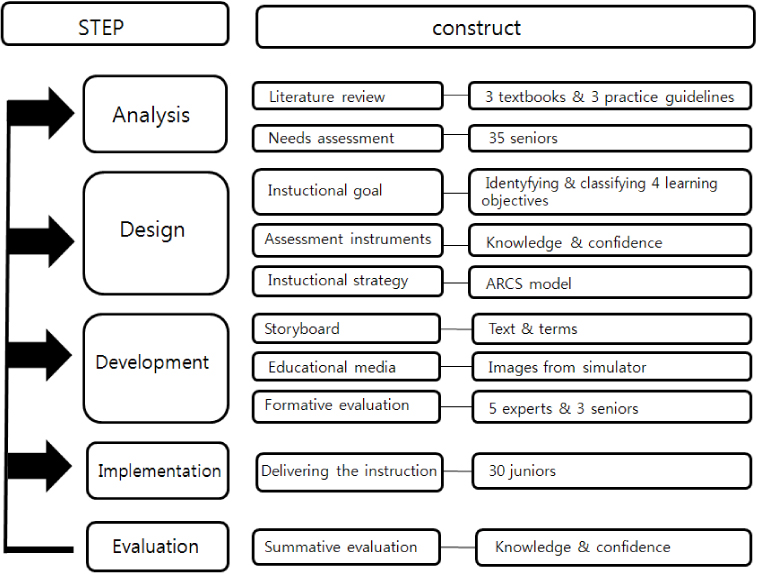Korean J Women Health Nurs.
2016 Mar;22(1):21-29. 10.4069/kjwhn.2016.22.1.21.
Development and Effects of Supplementary Material about Electronic Fetal Monitoring for Nursing Students
- Affiliations
-
- 1Department of Nursing, Kyongbuk Science College, Chilgok, Korea.
- 2Department of Nursing, Sahmyook University, Seoul, Korea. kimio@syu.ac.kr
- KMID: 2307908
- DOI: http://doi.org/10.4069/kjwhn.2016.22.1.21
Abstract
- PURPOSE
This study aimed to develop supplementary material about the electronic fetal monitoring for nursing students, and to test the effects on electronic fetal monitoring related knowledge and confidence on nursing performance in delivery room.
METHODS
Totally 58 nursing students were recruited either experimental group (n=30) or a control group (n=28). A non-equivalent control group pretest-posttest design was employed to test the effects on fetal monitoring related knowledge and confidence on nursing performance in delivery room. The supplementary material about the electronic fetal monitoring was developed based on Analysis, Design, Development, Implement and Evaluation (ADDIE) model. Fetal monitoring related knowledge and confidence on nursing performance in delivery room were self-reported by the scales that author developed. Data were collected at pre-test and after the 6-week intervention.
RESULTS
There was significant difference in confidence on nursing performance in delivery room between two groups after intervention.
CONCLUSION
These findings suggest the importance of the supplementary material about the electronic fetal monitoring for nursing students to improve confidence on nursing performance in delivery room.
Figure
Reference
-
1. King TL, Parer JT. On electronic fetal heart rate monitoring. J Obstet Gynecol Neonatal Nurs. 2011; Nov-Dec. 40(6):669–671.
Article2. Grant A, O'Brien N, Joy MT, Hennessy E, MacDonald D. Cerebral palsy among children born during the dublin randomised trial of intrapartum monitoring. Lancet. 1989; 2(8674):1233–1236.
Article3. Kim JI, Kang HS, Park SM, Ahn SH. Current status of women's health nursing practicum and direction. Korean J Women Health Nurs. 2014; 20(2):173–183.
Article4. Kim YM, Chun NM, Lee EH, Cho IS, Ahn SH, Kim JI, et al. Student experience and satisfaction with clinical nursing practice in women's health nursing. Korean J Women Health Nurs. 2011; 17(3):225–242.
Article5. Korean Nurses Association. Learning objective of nursing. 3rd revi. [Internet]. Seoul: Korean Nurses Association;2012. cited 2013 February 1. Available from: http://www.kan.or.kr/kor/sp_library/sp_library02.php?mode=view&number=3705&page=1&b_name=nurse_data.6. Mahley S, Witt J, Beckmann CA. Teaching nursing students to critically evaluate electronic fetal monitor tracings. J Obstet Gynecol Neonatal Nurs. 1999; 28(3):237–240.
Article7. Curriculum Society of Women's Health Nursing. Women's health nursing. 7th ed. Paju: Soomoonsa;2012.8. Susan SR. HW Kim . Essentials of maternity, newborn, and women's health nursing. 3rd ed. Seoul: Hyunmoonsa;2014.9. Sharon SM, Emily SM. YS Ha . Foundations of maternal-newborn nursing. 4th ed. Seoul: Shinkwang pub;2010.10. Kim GS, Lee NH. Women's health nursing clinical manual. Paju: Soomoonsa;2010.11. Kim JH. Women's health nursing: Guideline for clinical practice. Seoul: Hyunmoonsa;2011.12. Kwon SH, Kim SN, Park CH, Bae KU, Seo YS, Seong MH, et al. Maternity health nursing: Guideline for clinical practice. Seoul: Soomoonsa;2009.13. Keller JM. Motivational design for learning and performance: The ARCS model approach. New York, NY: Springer;2010.14. American College of Obstetricians and Gynecologists. Practice bulletin no. 116: Management of intrapartum fetal heart rate tracings. Obstet Gynecol. 2010; 116(5):1232–1240.15. National Institute of Child Health and Human Development Research Planning Workshop. Electronic fetal heart rate monitoring: research guidelines for interpretation. Am J Obstet Gynecol. 1997; 177:1385–1390.16. Association of Women's Health, Obstetric and Neonatal Nurses [AWHONN]. Fetal heart monitoring: Principles and practices. 4th ed. Washington, DC: Author;2009.17. Gilbert Elizabeth S.. Manual of High Risk Pregnancy and Delivery. 5th Ed. Mosby;2011.18. Miller LA, Miller DA, Tucker SM. Mosby's pocket guide to fetal monitoring: A multidisciplinary approach. Mosby;2012.19. Feltz DL. Self-confidence and sports performance. Exerc Sport Sci Rev. 1988; 16:151–166.
Article20. Yoon MS, Cho JY. Experience and confidence on clinical nursing performance in delivery room of nursing students according to the clinical practice settings. J Korean Data Anal Soc. 2010; 12(2):909–921.21. Chung CW, Kim HS, Park YS. Effects of high-fidelity simulation-based education on maternity nursing. Perspect Nurs Sci. 2011; 8(2):86–96.22. Song YA, Son YJ. Effects of simulation-based practice education for core skill of maternity nursing. Korean Parent Child Health J. 2013; 16(1):37–44.23. Shin HS, Shim KK. Nursing student's experiences on pediatric nursing simulation practice. J East West Nurs Res. 2010; 16(2):147–155.24. Lee HY, Lim HS, Kim MY. The clinical practice of newly graduated nurses who are resigned. Qual Res. 2011; 12(1):36–48.
- Full Text Links
- Actions
-
Cited
- CITED
-
- Close
- Share
- Similar articles
-
- Development and Effects of Supplementary Textbook about EKG for Nursing Students
- Electronic Fetal Monitoring: Past, Present and Future
- An Effect of the Application of Educational Electronic Nursing Record System for Nursing Students
- Fetal heart rate monitoring: from Doppler to computerized analysis
- Development and Effects of a Comprehensive Web-Based Nursing Process for Nursing Students



